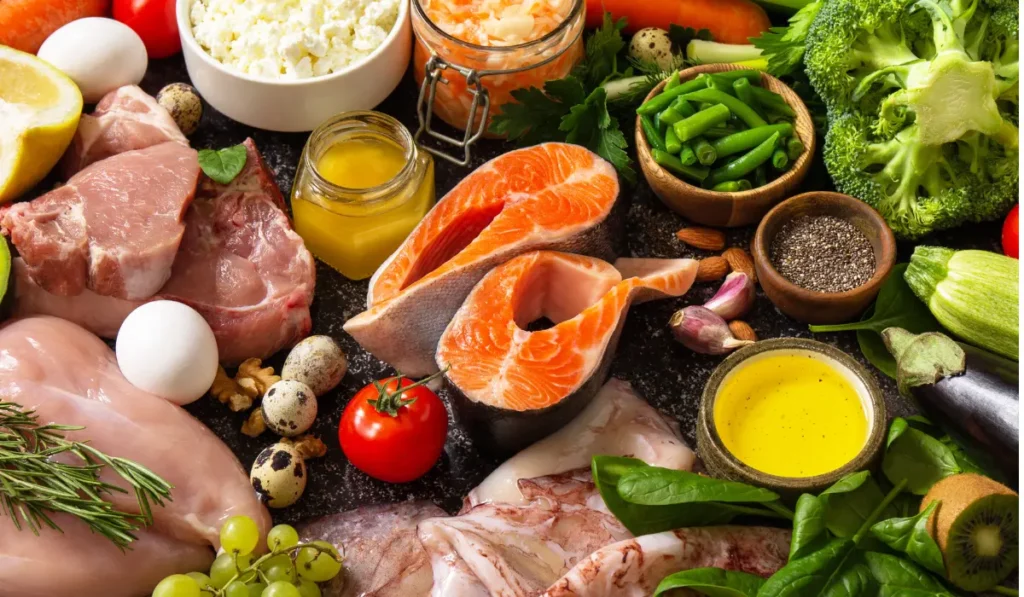Simple, unprocessed foods, similar to those of our Stone Age ancestors, are the foundation of the paleo diet. Fish, fresh foods, and lean meats are all part of it. The diet reduces salt, sugar, and carbohydrates. This diet does come with some risks, though.
Many people find that the paleo diet works well for them in terms of weight loss. It emphasizes lean proteins and whole foods. However, it excludes dairy and grains. Gaps in nutrition may result from this. Thus, it’s best to maintain a balanced diet and seek individual guidance from a health professional.
The Paleo Diet: What is it?
Eating Paleolithic-style foods is the foundation of the Paleo diet. Meats, seafood, nuts, leafy greens, local vegetables, and seeds are examples of this. It stays away from sugar, dairy, grains, and processed foods. Like our prehistoric ancestors, we want to consume more natural, whole foods.
The diet emphasizes what they eat, which is lean meats and plants because our bodies haven’t changed much since the Stone Age. Their active lifestyle, which included hunting, fishing, and food gathering, may have prevented the development of conditions like diabetes and cancer. But keep in mind that their lifespans were shorter than ours.
How Does the Paleo Diet Work?
The Paleo Diet operates as follows:
✨ Food Selections: The diet consists of hunted or gathered items such as fish, lean meats, fruits, vegetables, nuts, and seeds. It places a focus on whole, unprocessed foods.
✨ Excluded Foods: There are no prepared meals or brand-new farm equipment available. That means no milk, white sugar, cereal (like wheat and rice), or added fats of any kind.
✨ Nutritional Approach: High in protein and fiber, the Paleo Diet is based on whole foods. It typically contains less fat and less carbohydrates. Also, this equilibrium can lessen edema, enhance nutrient absorption, and maintain stable blood sugar levels.
✨Health and Weight Loss: Many Paleo Dieters experience weight loss because they cut back on quick and high-calorie meals. Eating a diet high in fruits, vegetables, and light proteins can also aid in muscle growth. It increases heart health and vitality in general.
What Does a Paleo Diet Contain?
The specific guidelines for the Paleo Diet in books and online resources differ slightly. Still, it usually follows certain dietary recommendations.
Foods To Add
- a range of veggies and fresh fruits.
- a variety of seeds and nuts
- Eggs
- Lean meats, preferably from wild game or grass-fed cattle.
- Fish high in omega-3 fatty acids include albacore tuna, salmon, and mackerel.
- Natural oils are derived from nuts and fruits, such as walnuts and olive oil.
Foods To Avoid

- Every grain, comprising barley, oats, and wheat
- Legume crops, including peanuts, beans, and lentils
- dairy goods, such as cheese and milk
- Any type of added or refined sugar
- Too much salt
- White potatoes, peas, jicama, and corn are a few starchy vegetables.
- Highly processed foods like cookies and chips.
Is The Paleo Diet Healthy?
The health benefits of the paleo diet remain unclear due to a lack of long-term studies. Naturally raised meat, fish, vegetables, and fruits are the mainstays of this diet. It advises staying away from grains and dairy products.
Although this might be a good way to eat healthily, there are some issues. The possibility of calcium and vitamin D deficiency is one major risk. The health of your bones depends on these nutrients.
Furthermore, a paleo diet frequently results in high intakes of protein and saturated fat. The primary cause of this is eating meat. This overindulgence may increase the risk of certain cancers, heart disease, and kidney disease.
For the brain and muscles to function at their best, carbohydrates are necessary. Complex ones derived from fruits, vegetables, and whole grains are especially crucial. But it’s best to limit your consumption of refined carbohydrates. These consist of chips, sweetened beverages, and desserts.
These foods increase calorie intake. Also, they are deficient in fiber, protein, vitamins, and minerals, among other healthy nutrients. To improve their nutritional profile, a lot of processed foods are also artificially fortified.
Supplements of calcium and vitamin D may be necessary for those who consume less dairy. This is particularly true if they don’t consume any other foods high in calcium. Dairy products, according to some Paleo diet proponents, can induce inflammation. Low-fat dairy products may lower blood markers of inflammation, according to research.
Some Health Benefits Of The Paleo Diet
- Heart Health And Weight Loss
Those who followed the Paleo diet for a full year saw weight loss. Additionally, they observed improved cholesterol, blood pressure, and waist size. The heart may benefit from this.
- More Beneficial for Diabetes
In a different study, participants with type 2 diabetes followed a 12-week Paleo diet. They observed reduced levels of blood sugar, body fat, and insulin sensitivity. Results were even better for those who exercised as well.
- Reduces Sensitivity to Insulin
Studies reveal that type 2 diabetics find it simpler to regulate their blood sugar when following the Paleo diet. It also improved their insulin-using abilities.
- Autoimmune Diseases
One way to reduce swelling in autoimmune diseases is to follow the Paleo diet. A study on bowel disease patients revealed that many of them felt better after following this diet.
Is Everyone Fit to Follow a Paleo Diet?
Everybody responds differently to the Paleo diet. It’s critical to assess your feelings regarding the diet and consult your physician regarding any health issues. For their diet to be effective, some individuals may need to make a few small adjustments.
Eating a lot of meat isn’t the only aspect of the diet. It also involves consuming an abundance of vegetables, which are crucial for overall health. Recall that not all processed foods, even those without grains, legumes, or sugar, fit into this diet.
Beginning a Paleo diet requires you to cook at home and purchase fresh food, in addition to being physically active. Certain people may find this challenging. For vegetarians or vegans, in particular, it can be particularly difficult because their diet excludes legumes, which they depend on for protein.
Conclusion
Fresh produce, seafood, and lean meats are the mainstays of the Paleo diet. It reduces the consumption of grains, dairy, and processed foods. This strategy may work well for reducing weight and enhancing specific health issues.
It might, however, leave some dietary gaps, particularly in the areas of calcium and vitamin D. Consult a specialist and do some research before beginning this diet. Thus, to maintain your health, you may need to make dietary adjustments for balanced nutrition.

